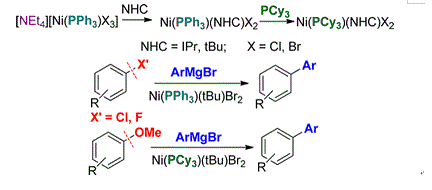Jie Zhang, Jin Xu, Yanchao Xu, Hongmei Sun*(孙宏枚), Qi Shen, and Yong Zhang
The Key Laboratory of Organic Synthesis of Jiangsu Province, College of Chemistry, Chemical Engineering and Materials Science, Soochow University, Suzhou 215123, People’s Republic of China
Organometallics, 2015, 34 (24), pp 5792–5800
New methods for the preparation of mixed NHC/phosphine Ni(II) complexes have been developed. It was shown that the quaternary ammonium cation in the easily available Ni(II) complexes [NEt4][Ni(PPh3)X3] (X = Cl and Br) can act as a good leaving group in reactions of [NEt4][Ni(PPh3)X3] with the bulky ItBu (ItBu = 1,3-ditertbutylimidazol-2-ylidene) or IPr [IPr = 1,3-bis(2,6-diisopropylphenyl)imidazol-2-ylidene] ligand, resulting in the corresponding mixed NHC/PPh3 Ni(II) complexes Ni(PPh3)(ItBu)X2 (X = Cl, 1; X = Br, 2) or Ni(PPh3)(IPr)Br2 (3) in high yields. The PPh3 ligand in these obtained mixed NHC/PPh3 Ni(II) complexes can be easily substituted by a more electron-donating phosphine ligand, i.e., PCy3, resulting in the corresponding mixed NHC/PCy3 Ni(II) complexes Ni(PCy3)(ItBu)Br2 (4) and Ni(PCy3)(IPr)Br2 (5) in high yields. The crystal structures of these Ni(II) complexes have been characterized, which revealed a trans disposition of the NHC ligand to the phosphine ligand. The catalytic behaviors of them on varying the carbene ligand (ItBu vs IPr) as well as the phosphine ligand (PPh3 vs PCy3) were investigated in the cross-coupling of aryl Grignard reagents with a wide range of electrophiles. In addition to a significant synergic effect on their catalytic activities, high selectivity for the activation and transformation of C–Cl, C–F and C–O bonds was achieved based on the rational structural design. Complex 2 showed the highest catalytic activity for the cross-coupling of aryl chlorides and fluorides with aryl Grignard reagents, but exhibit little activity for the cross-coupling of aryl methyl ethers with aryl Grignard reagents. On contrast, complex 4 showed great potential for the aryl methyl ethers involved cross-coupling reactions, although its reactivity for the activation of the C–X bond is very poor. The difference in catalytic activity between 2 and 4 has been successfully employed to construct oligoarenes by selective cross-coupling reactions.

链接://pubs.acs.org/doi/abs/10.1021/acs.organomet.5b00874